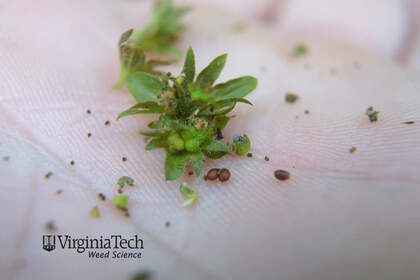Virginia threeseed mercury
Family
EuphorbiaceaeScientific Name
Acalypha virginicaOther Common Names:
Virginia copperleaf
wax balls
threeseeded mercury
mercuryweed
Habit
This summer annual produces flowers from June through October.
Leaves
The leaves are opposite when it's young but it becomes alternate later along the hairy stems. The leaves have toothed margins and turn a copper color with age. The lanceolate leaves can grow from 3/4 to 3 inches long.
Identifying Characteristics
This plant can be identified by copper-colored young leaves and by axillary flower clusters.
Flower Seed Head
Male and female flowers are produced separately on the same plant (monoecious). Both flower types are greenish, inconspicuous, and produced in clusters in the leaf axils on the upper portions of the stem. Female flowers are surrounded by conspicuous, bracts that have 9 to 15 deep lobes.
Seed Fruit
The egg-shaped seeds grow from 1.4 to 1.8 mm long in a 3-lobed seed pod. The seeds are dull reddish-brown or gray with reddish-brown spots.
Where Found
Plants are found from Maine to Florida, west to South Dakota and Texas. They occur throughout much of the eastern two-thirds of the United States. Plants are common in poorly managed turfgrass and pastures. Large populations will occur following tillage.
Growth Habit
upright and nonwoody
Thorns or Spines
not present
Dominant Flower Color
red
Flower Symmetry
radial symmetery
Leaf Hairs
Varies:
has hairs,
no hairs
Leaf Shape
lance
Leaf Arrangement
alternate
Leaf Margin
Varies:
entire,
serrated
Leaf Structure
simple
Leaf Stalk
shorter than leaf
Stem Hairs
has hairs
Stem Cross Section
round or oval
Milky Sap
not present
Root Structure
taproot
Life Cycle
summer annual
Ochrea
not present
Plant Type
Herb











